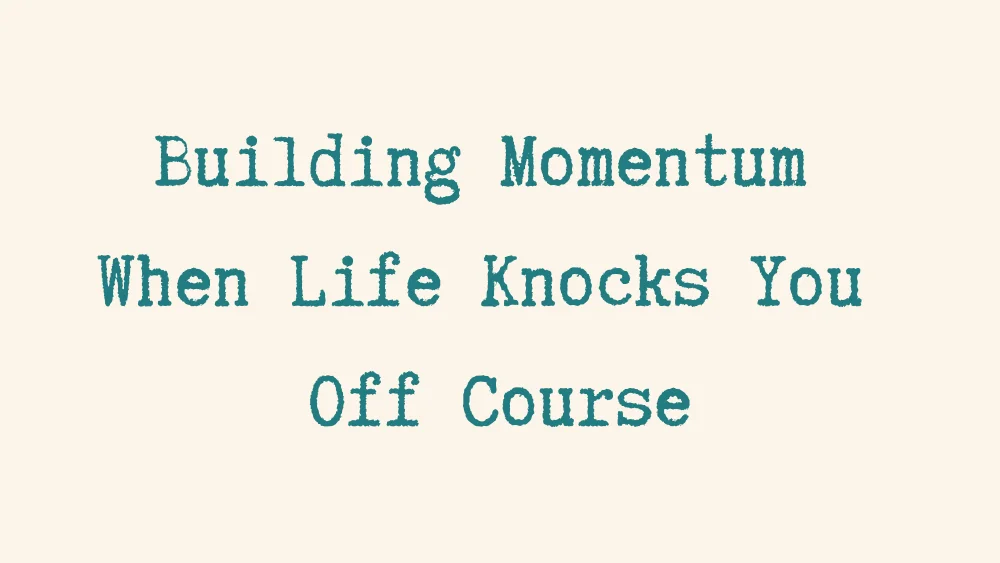When Goals Change: How to Restructure Without Losing Momentum

Thanks, for sharing:
Most of us are taught to set goals as if they are promises and unbreakable, linear, and fixed. But life rarely moves in straight lines. Jobs shift. Energy changes. What felt meaningful a year ago might feel heavy now.
When a goal stops fitting, we often interpret it as failure. We assume we lost discipline or motivation. In truth, what often changes is alignment. The goal that once pulled you forward no longer matches who you are becoming.
At Inspirational Guidance, we believe progress is not about perfection. It is about direction. And direction is allowed to change. Learning to restructure your goals, instead of abandoning them or pushing through with frustration is what keeps you moving without losing heart.
Why It Can Feel Hard
Changing a goal can feel like betrayal. You told yourself you would finish the course, launch the project, or reach the milestone by a certain date. Letting go or shifting feels like letting yourself down.
But goals are meant to serve you rather than keep you trapped. Their purpose is to provide clarity. When you grow, your definitions of success need to grow with you. The discomfort you feel is not weakness it is awareness. It means you are paying attention. And that awareness is the foundation of intentional living.
How to Restructure Goals Without Losing Momentum
1. Revisit the “Why.”
Ask what this goal was meant to give you, e.g. confidence, stability, creativity, freedom? Sometimes the outcome still matters, but the path no longer does. Keep the essence, not the outdated form.
2. Reduce the Scale, Not the Vision.
Momentum thrives on small wins. If the original plan feels too heavy, narrow the time frame or reduce the output. Completing one small step that matters today is more powerful than waiting to feel ready for a perfect restart.
3. Redefine What Progress Looks Like.
Progress is not always visible. It might look like making a decision faster, saying no sooner, or choosing rest instead of burnout. Celebrate the quiet evidence that you are still moving forward.
4. Create Flexible Checkpoints.
Rigid deadlines often create guilt rather than growth. Replace hard timelines with regular reflections: “Is this still aligned?” “What needs adjusting?” Momentum comes from course correction, not self-criticism.
5. Anchor Goals to Your Values.
Your values are your constant - goals are the experiments. When your values guide your choices, every pivot becomes purposeful. You are not giving up; you are refining what fits.
Everyday Examples
You planned to journal daily but manage three times a week. Instead of “failing,” you can celebrate consistency. The value which is reflection is being lived.
You aimed to grow a business but realize you want more creative freedom than scale. Adjust the model, not the dream.
You wanted to exercise five days a week but discover long walks and stretching serve you better right now. The goal shifted; the self-care stayed.
Restructuring goals is not quitting, it is maturity. It is what happens when purpose becomes stronger than performance.
Apply the Learning in Small Ways
This week, take one goal that feels stuck or outdated and ask yourself:
- What was the original purpose of this goal?
- What still feels true about it and what feels heavy or irrelevant?
- How could I reframe it so it fits the person I am becoming, not the one who started it?
Rewrite the goal in plain language, anchored to your current reality. Make it lighter, smaller, and truer. That is how momentum stays alive.
Capture the Takeaway
Momentum is not about endless hustle. It is about staying in motion through change. When you restructure goals consciously, you stop judging your pace and start trusting your process. Every shift is information. Every adjustment is progress. You are not starting over you are starting aligned.
Reflective Prompts to Try This Week
- Which of my current goals feels out of sync with who I am now?
- What outcome still matters, even if the path changes?
- How could I measure progress in smaller, more meaningful ways?
- What evidence do I already have that I am still moving forward?
- If I gave myself permission to adapt, what would I change first?
Frequently Asked Questions
Do I need to have clear goals to make progress?
Not always. Many people wait for clarity before taking action, but in reality, movement often creates clarity. Progress begins the moment you take one small step that feels meaningful. Over time, that step reveals the next, and direction emerges naturally. Instead of waiting for a perfect plan, focus on what matters right now. Even small, incomplete goals teach you something about your values, energy, and priorities. That learning is progress, even when the path isn’t fully defined.
What if I change my mind too often?
Changing direction frequently can feel like inconsistency, but it often means you are listening to yourself. Growth naturally brings new information and sometimes, your goals need to evolve to stay relevant. The key is reflection, not rigidity. Ask yourself why the change feels necessary: is it avoidance, or is it alignment? If it moves you closer to your core values or restores energy you lost, it’s a conscious pivot, not a setback. Momentum grows when flexibility replaces guilt.
How often should I review my goals?
A monthly or quarterly review is ideal, giving you enough time to test progress without losing perspective. Regular reflection helps you notice small shifts before they become frustration. It also lets you recalibrate based on energy, priorities, and external changes. Use your review to ask: “What worked?” “What drained me?” “What still feels meaningful?” You are not starting over each time — you are refining. Purposeful reviews turn goal setting into an ongoing conversation, not a one-time commitment.
Can I still use the goal tracker if I’m restructuring my goals?
Yes — in fact, the tracker becomes even more valuable when you are adjusting goals. It provides a visible record of learning, experimentation, and growth. Instead of measuring only outcomes, use it to capture insights: what you changed, why it mattered, and what patterns you notice. Over time, this reflection turns your tracker into evidence of resilience. You will see that your path may not be linear, but it is still consistent, a clear sign of progress that feels personal and sustainable.
What if I feel guilty for letting go of a goal?
Guilt often appears when we equate consistency with worthiness. But releasing a goal that no longer fits is not failure, it is maturity. Letting go creates space for something truer to your current season of life. Reflect on what the old goal once gave you, then thank it for serving its purpose. The goal did its job if it helped you grow, even temporarily. Progress is not about stubborn completion; it is about alignment. You are allowed to evolve without apology.
Related Posts

Building Momentum When Life Knocks You Off Course

How to Keep Going When the Motivational Spark Fades

Momentum Over Motivation: Why Small Steps Beat Big Bursts